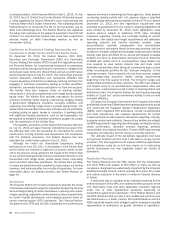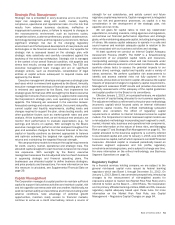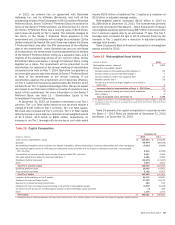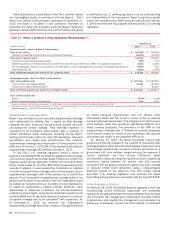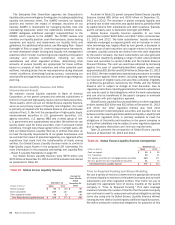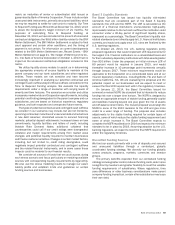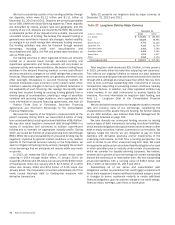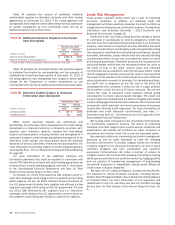Bank of America 2013 Annual Report Download - page 66
Download and view the complete annual report
Please find page 66 of the 2013 Bank of America annual report below. You can navigate through the pages in the report by either clicking on the pages listed below, or by using the keyword search tool below to find specific information within the annual report.64 Bank of America 2013
Regulatory Capital Changes
Market Risk Final Rule
At December 31, 2013, we measured and reported our capital
ratios and related information in accordance with the Basel 1 –
2013 Rules, which introduced new measures of market risk
including a charge related to stressed Value-at-Risk (VaR), an
incremental risk charge and the comprehensive risk measure
(CRM), as well as other technical modifications, all of which were
effective January 1, 2013. The CRM is used to determine the risk-
weighted assets for correlation trading positions. With approval
from U.S. banking regulators, but not sooner than one year
following compliance with the Market Risk Final Rule, we may
remove a surcharge applicable to the CRM. This benefit is not yet
included in our reported results. The implementation of the Basel
1 – 2013 Rules was the primary driver of the changes in total risk-
weighted assets, and the Tier 1, Tier 1 common and Total capital
ratios from December 31, 2012.
In December 2013, U.S. banking regulators issued an
amendment to the Market Risk Final Rule, effective on April 1,
2014, to reflect certain aspects of the final Basel 3 Regulatory
Capital rules (Basel 3). Revisions were made to the treatment of
sovereign exposures and certain traded securitization positions
as well as clarification as to the timing of required disclosures.
These revisions are not expected to materially impact us.
Basel 3 Regulatory Capital Rules
The final Basel 3 rules became effective on January 1, 2014.
Various aspects of Basel 3 will be subject to multi-year transition
periods ending December 31, 2018 and Basel 3 generally
continues to be subject to interpretation by the U.S. banking
regulators. Basel 3 will materially change our Tier 1 common, Tier
1 and Total capital calculations. Basel 3 introduces new minimum
capital ratios and buffer requirements and a supplementary
leverage ratio; changes the composition of regulatory capital;
revises the adequately capitalized minimum requirements under
the Prompt Corrective Action framework; expands and modifies
the calculation of risk-weighted assets for credit and market risk
(the Advanced approach); and introduces a Standardized approach
for the calculation of risk-weighted assets. This will replace the
Basel 1 – 2013 Rules effective January 1, 2015. For more
information on the Standardized approach, see page 65.
Under Basel 3, we are required to calculate regulatory capital
ratios and risk-weighted assets under both the Standardized
approach and, upon notification of approval by U.S. banking
regulators anytime on or after January 1, 2014, the Advanced
approach. For 2014, the Standardized approach uses risk-
weighted assets as measured under the Basel 1 – 2013 Rules
and Basel 3 capital in the determination of the Basel 3
Standardized approach capital ratios. The approach that yields the
lower ratio is to be used to assess capital adequacy including
under the Prompt Corrective Action framework. Prior to receipt of
notification of approval, we are required to assess our capital
adequacy under the Standardized approach only. The Prompt
Corrective Action framework establishes categories of
capitalization, including “well capitalized,” based on regulatory
ratio requirements. U.S. banking regulators are required to take
certain mandatory actions depending on the category of
capitalization, with no mandatory actions required for “well-
capitalized” banking entities. While we continue to evaluate the
impact of both the Standardized and Advanced approaches, we
generally expect that initially the Standardized approach will yield
lower ratios.
In November 2011, the Basel Committee on Banking
Supervision (Basel Committee) published a methodology to
identify global systematically important banks (G-SIBs) and impose
an additional loss absorbency requirement through the
introduction of a buffer of up to 3.5 percent for systemically
important financial institutions (SIFIs). The assessment
methodology relies on an indicator-based measurement approach
to determine a score relative to the global banking industry. The
chosen indicators are size, complexity, cross-jurisdictional activity,
interconnectedness and substitutability/financial institution
infrastructure. Institutions with the highest scores are designated
as G-SIBs and are assigned to one of four loss absorbency buckets
from one percent to 2.5 percent, in 0.5 percent increments based
on each institution’s relative score and supervisory judgment. The
fifth loss absorbency bucket of 3.5 percent is currently empty and
serves to discourage banks from becoming more systemically
important.
In July 2013, the Basel Committee updated the November
2011 methodology to recalibrate the substitutability/financial
institution infrastructure indicator by introducing a cap on the
weighting of that component, and require the annual publication
by the Financial Stability Board (FSB) of key information necessary
to permit each G-SIB to calculate its score and observe its position
within the buckets and relative to the industry total for each
indicator. Every three years, beginning on January 1, 2016, the
Basel Committee will reconsider and recalibrate the bucket
thresholds. The Basel Committee and FSB expect banks to change
their behavior in response to the incentives of the G-SIB framework,
as well as other aspects of Basel 3 and jurisdiction-specific
regulations.
The SIFI buffer requirement will begin to phase in effective
January 2016, with full implementation in January 2019. Data
from 2013, measured as of December 31, 2013, will be used to
determine the SIFI buffer that will be effective for us in 2016.
As of December 31, 2013, we estimate our SIFI buffer would
be 1.5 percent, based on the publication of the key information
used in the SIFI methodology by the Basel Committee in November
2013, and considering the FSB’s report, “Update of group of global
systemically important banks.” Our SIFI buffer could change each
year based on our actions and those of our peers, as the score
used to determine each G-SIB’s SIFI buffer is based on the industry
total. If our score were to increase, we could be subject to a higher
SIFI buffer requirement. U.S. banking regulators have not yet
issued proposed or final rules related to the SIFI buffer or
disclosure requirements.
Regulatory Capital Transitions
Important differences in determining the composition of regulatory
capital between Basel 1 – 2013 Rules and Basel 3 include changes
in capital deductions related to our MSRs, deferred tax assets and
defined benefit pension assets, and the inclusion of unrealized
gains and losses on AFS debt and certain marketable equity
securities recorded in accumulated OCI, each of which will be
impacted by future changes in interest rates, overall earnings
performance or other corporate actions.




